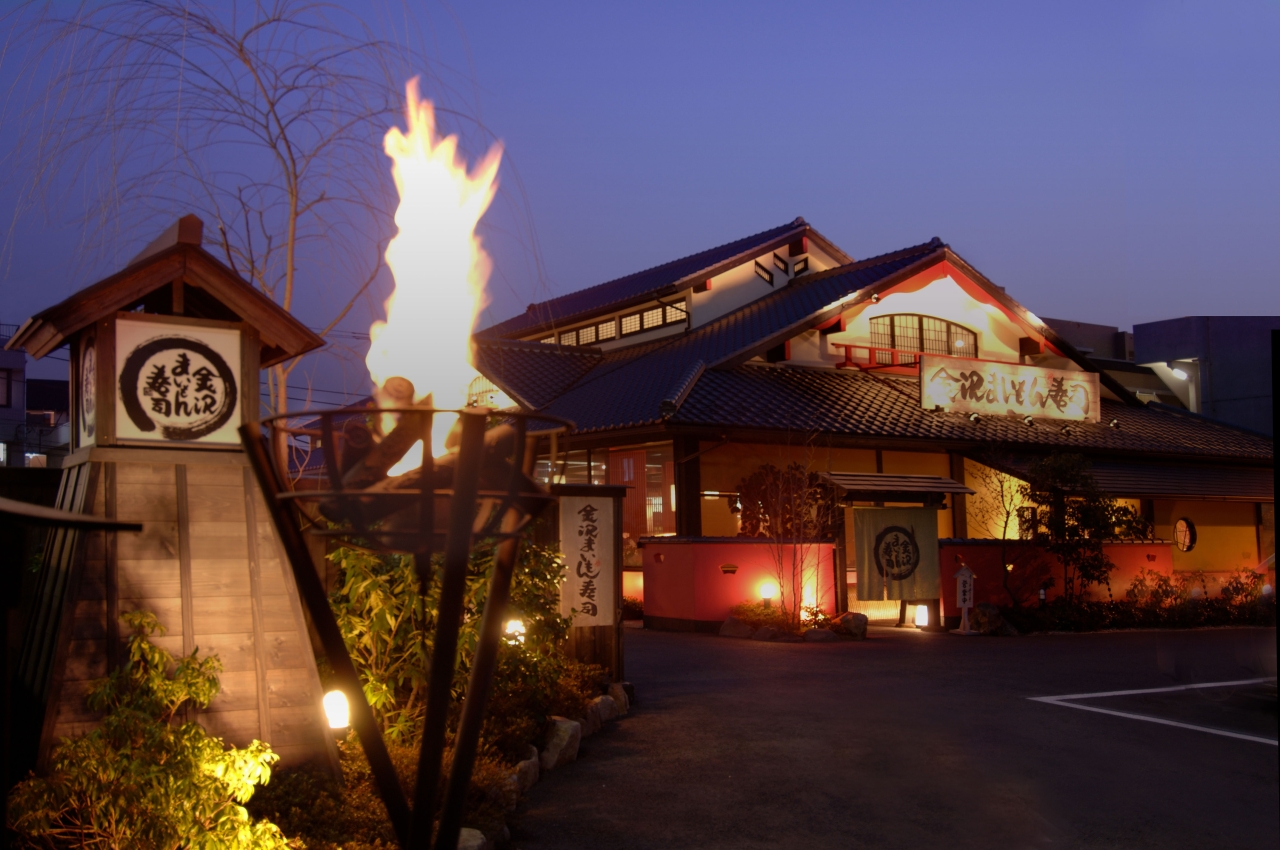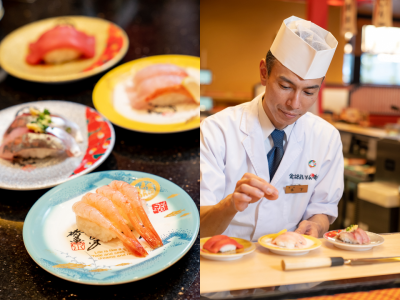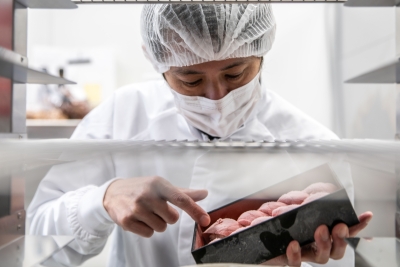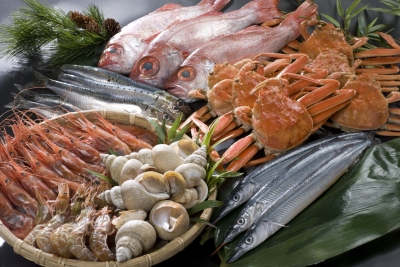SUSHI×TECHNOLOGY Pioneering the Future of Food Culture from Kanazawa.

Kanazawa City in Ishikawa Prefecture in Japan’s Hokuriku area is known for Kenroku-en Garden, Kanazawa Castle, and the Nagamachi Samurai District, all of which are steeped in the history and culture of the expansive former Kaga domain; as well as magnificent food culture that incorporates the delights of the Sea of Japan. Kanazawa Maimon Sushi was first launched in Kanazawa City in 2000. Extremely popular as a high-quality, gourmet kaitenzushi (conveyor-belt sushi) restaurant, Kanazawa Maimon Sushi has attracted a lot of media attention. M&K Corporation is the restaurant’s managing company, and using Kanazawa as its platform, it is currently working to expand the potential of sushi worldwide as a central element of Japan’s food culture. Kanazawa Maimon Sushi has in place a unique strategy for the future of sushi—this has the potential to impact significantly on food not only in Japan, but around the world.
Creating a New Business Model through Ideas and Preferences Free of Industry Conventions.
“I’ve never made sushi or cooked anything myself,” says Koji Kinoshita, representative director of M&K Corporation. A qualified first-class architect, Kinoshita is a unique manager in the restaurant industry. Interested in food from a young age, after managing a fishmongers, in 1999 Kinoshita opened the Yokaichi Branch of Kanazawa Dekaneta Sushi. At the same time he set up M&K Corporation, and the following year he launched Kanazawa Maimon Sushi.
“One of the main reasons I decided to move into the world of kaitenzushi was that I had some issues with the restaurant industry at the time. My idea was to provide dishes that I really wanted to eat myself, and that I wanted my family to eat. This mindset is still the starting point of my management today,” says Kinoshita.
While many other kaitenzushi restaurants use frozen ingredients, Kanazawa Maimon Sushi offers its customers fresh ingredients from the Sea of Japan that can’t be found elsewhere, such as blackthroat seaperch, Japanese glass shrimp, and the Japanese ivory shell. These are all prepared in-store from scratch by first-rate sushi chefs who not only boast outstanding skills, but also excellent hospitality and customer service capabilities. These human resources are something the restaurant is very particular about. The design of the restaurants themselves, meanwhile, incorporate Kinoshita’s unique perspectives as a first-class architect. The interiors are based on the concept of miyabi, the Japanese aesthetic, to provide customers with an extraordinary space in which to dine. Invoking images of the former Kaga domain, the restaurants offer a unique presence through reds from bengara seen in teahouses, blacks from Wajima-nuri lacquerware, and the golds of gold leaf.
By bringing together ideas and individual preferences that stay away from industry conventions—that is, combining seasonal ingredients, first-rate sushi chefs, and interior design—Kinoshita has successfully created a new business model through Kanazawa Maimon Sushi. Perhaps it wouldn’t be an exaggeration to say that he has transformed the value of kaitenzushi itself.
The restaurant has already achieved remarkable growth with 20 stores in Japan and one in Taiwan, and according to Kinoshita, “It is exciting to think what the future holds.” In this sense, the restaurant’s strategy for the future has just begun.
“Since we launched the restaurant, my goal has been to spread Japan’s food culture worldwide. Japan is home to many excellent cultural, historical, and traditional assets, and Kanazawa in particular has a deep knowledge of its cultural assets. My hope is to transmit the value of sushi as well as various Japanese cultures as an added value.”
SUSHI×TECHNOLOGY Enhancing the Possibilities for Food Culture.
In 2022, Kanazawa Maimon Sushi opened a sushi factory in Dubai as one element of its future strategy. With this as a start, we began to realize an unprecedented overseas expansion plan to supply authentic sushi made in Japan using seasonal ingredients to all parts of the world via reefer containers.
“After looking at many different methods, we finally acquired expertise on defrosting technologies that would ensure flavors that were on par with freshly made sushi. We are now actively engaged in sales and marketing activities with a view to expanding into in-flight meals and takeaway options atluxury supermarkets in North America and Europe,” says Kinoshita.
Through new frozen sushi technologies, Kinoshita is edging ever closer to his dream of providing customers across the world with authentic sushi, just like the sushi you tastein Japanese sushi restaurants. Elsewhere, to ensure stable supplies, the farming of high-value-added seafood to secure the relevant ingredients is paramount. M&K Corporation is fully prepared in this area, too, having already welcomed a seafood processing company into the group through M&A.
Moreover, when considering food resources, a commitment to sustainable practices is essential. Here, the company has made use of advanced technologies to develop fish recognition software in order to conserve fish protein ecosystems, and to visualize and optimize supply chain networks through use of tracking technologies. For its export strategies, the company is planning to work with a major trading company with significant expertise in related fields. “If we are going to be on the global stage, our business attitude should also be of a global standard,” says Kinoshita, showing his unshakeable pride and commitment as a manager.
The role of authentic Japanese sushi using seasonal ingredients and made by expert chefs as a platform for Japanese food culture will have a major advancements not only on the restaurant and fisheries industries, but also on the Japanese industry as a whole.
As an individual involved in the Japanese food industry for nearly 30 years, Kinoshita’s desire is for us to reaffirm the outstanding strength and value of Japanese food culture.
Transforming Maimon into a Globally Recognized Brand
Maimon means “something delicious” in the local Japanese dialect. The name reflects Kinoshita’s founding desire—to provide dishes that he really wants to eat himself, and that he wants his family to eat. In the past 20 years, Japan and its restaurant industry have undergone major changes and experienced several crises. The journey of M&K Corporation has not been smooth sailing, either. That said, it has been the company’s human resources, its employees, who have been the driving force in overcoming the numerous failures they have experienced.
To make employees work with pride, the company places a firm focus on human resource development. In addition to enhancing training programs to improve hospitality and other skills, the company is increasing restaurant independence and actively transferring discretionary authority.
Kinoshita says, “Human resources are the source of corporate value and differentiation from the competition. This is why we spare no time or investment in human resource development. Also, we believe that creating company appeal is just as important as human resource development.” If M&K can find success on the global stage, employees will be excited to work there. Kinoshita says that it is the manager’s responsibility to create an environment in which each employee can work toward their hopes and dreams for the future.
Today, the M&K Group has 15 affiliated companies, and a total of 48 facilities, including restaurants and factories. Moving forward,. the company plans to expand to various countries in order to spread the splendor of SUSHI’s food culture all over the world. As part of its strategies for inbound tourism, which previously focused on visitors from Asia, employees are currently leading a project to uncover new demand through one-to-one marketing activities geared toward wealthy visitors from Europe.
As he moves forward with global expansion, Kinoshita’s aim is establishing the Maimon brand in which the value of every element has increased, including the design and corporate image besides its sushi. By providing products as a single package and differentiating itself from rival companies, the company aims to develop into a strong organization that can take on global competition.
“There are still many things that I want to and should do, whether it is further overseas expansion, regional development, or solving social challenges. If I can pave the way for these initiatives, I hope that the next generation will do the rest,” says Kinoshita with a big smile.









